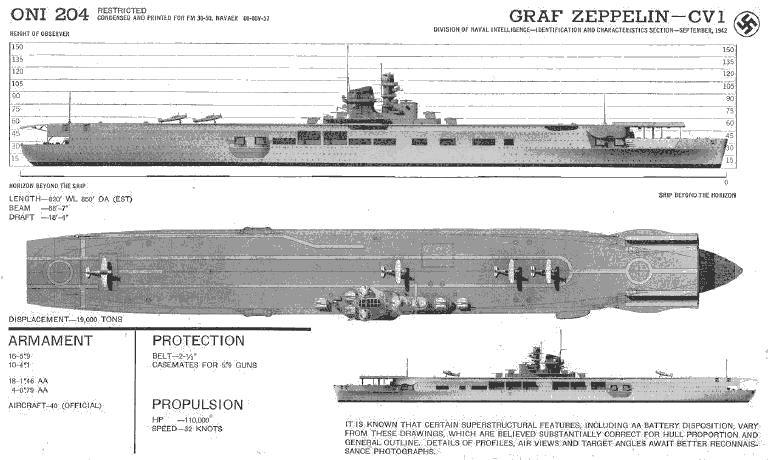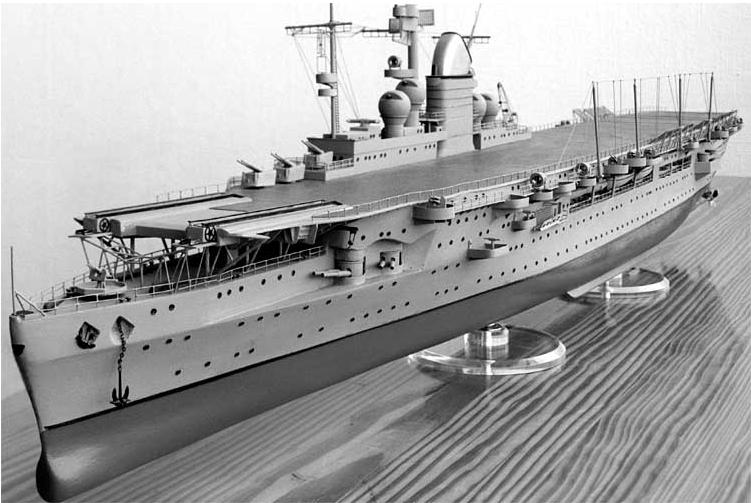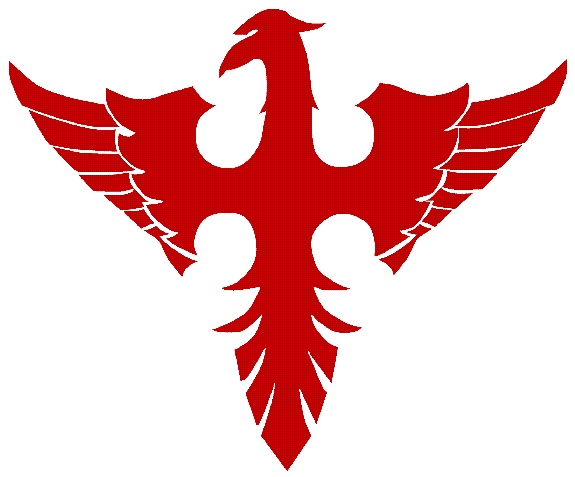Hitler had promised the German Navy (The Kriegsmarine) carriers as early as 1935, and the keels of two were laid down the next year. Two years later, Grand Admiral Erich Raeder presented an ambitious shipbuilding program called the Z Plan, in which four carriers were to be built by 1945. In 1939, he revised the plan, reducing the number to be built to two. The Graf Zeppelin was 920 feet long and weighed 19,250 tons. Her top speed was to be 33.8 knots. Her crew complement was 1,760 and she was to hangar forty aircraft. By comparison the large American Essex class carriers of WWII could carry 80 to 100 aircraft. The Germans got as far as partly installing the catapults when the ship was then turned into a floating warehouse for u-boat parts. 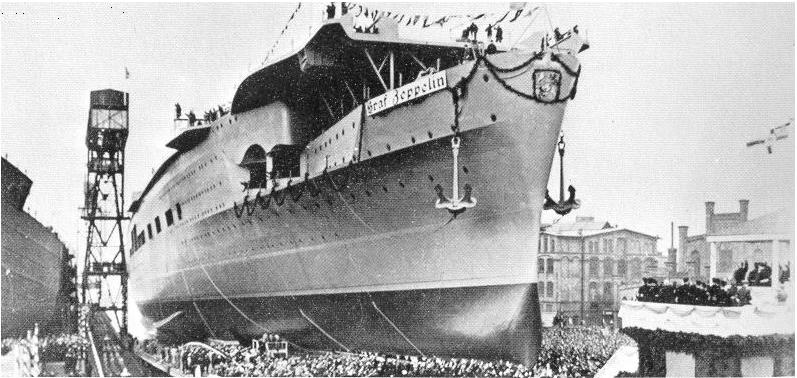
Kreigsmarine Aircraft Carriers - Graf Zeppelin Class ==========================================================================
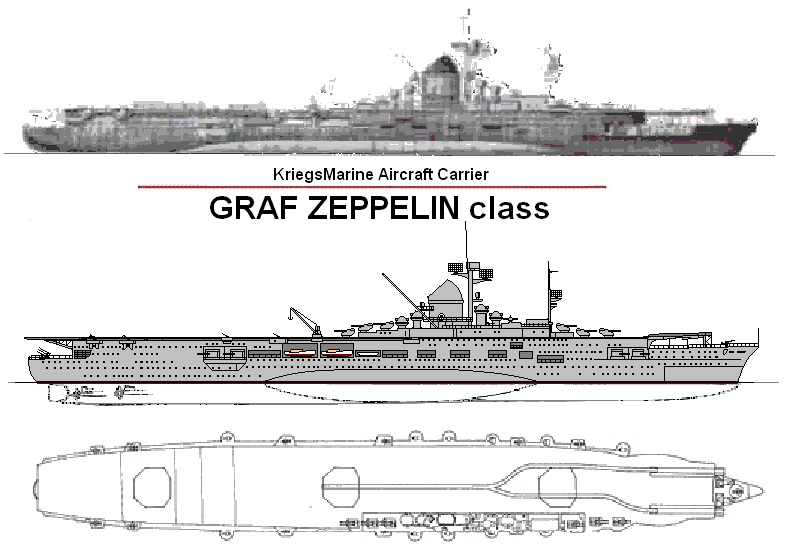
Hitler's attitude vacillated on the project and it never had his full backing. It also had a major detractor in Goering, who was resentful of any incursion on his authority as head of the country's air power. Goering had been ordered by Hitler to develop aircraft for the ship. His response was to offer redesigned versions of the then-obsolete JU-87 Stuka dive bomber and older versions of the Messerschmitt 109 fighter. Both planes were land-based aircraft never intended to meet the rough requirements for carrier operations. Even after modifications they were hopelessly inferior to Allied types. To insure further delay in the carrier’s completion, Goering informed Hitler that these planes would not be ready until the end of 1944. Goering’s tactics worked and the Graf Zeppelin’s construction was halted in 1943.
By the time work stopped on the ship, the Germany Navy had a submariner as its top naval officer– Admiral Karl Donitz– and all ship construction was turned over to building new U-Boats. The Graf Zeppelin stayed at her moorings in Stettin for the rest of the war.
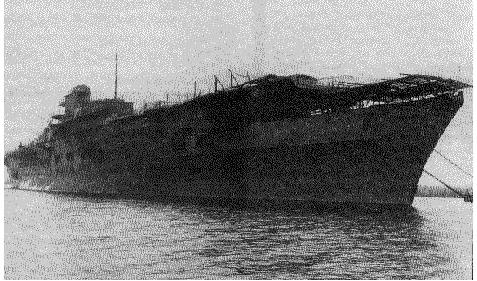
In no naval action of World War 2 will you find a German aircraft carrier taking part. All the major navies in the war used them extensively, except for Nazi Germany. There were lots of German U-Boats, battleships, cruisers, and destroyers, but no flattops. However, the Nazis did have plans to build a total of four carriers and even almost finished one of them.
The Graf Zeppelin class aircraft carriers were two German Kriegsmarine aircraft carriers laid down in the mid-1930s as part of the Plan Z rearmament program.
The first (and only) class of carriers to be laid down by the Germans. This program was subject to political arguments over which service would operate the aircraft, leading to delays; wartime events brought the program to a halt, and it was killed by Hilter's decision to devote most naval resources to the submarines.

Initially conceived as a ship very similar to HMS Courageous. The design was modified and emerged with many features typical of European carrier design, especially heavy armor and armament. The Graf Zeppelin class was to provide the commerce-raiding capital ships and cruisers with air cover, and would have increased their potential for destruction considerably. The ship was very fast so she could outrun raiders or hunters. The armament was designed to counter surface ships and aircraft, leading to significant inefficiencies. The aircraft would have been modified land-based types. However, Aircraft operating features were poorly designed due to a total lack of experience in shipboard aircraft operation. The design was also subject to several changes dictated by wartime events.
In 1935, Germany's first aircraft carrier was ordered, the KMS Graf Zeppelin. However construction delays, lack of aircraft, and bitter disputes between Air Marshall Herman Goering and the Navy (over his reluctance to allow a separate air arm other than the Luftwaffe) insured that the ship was doomed to become scrap metal.
Graf Zeppelin -
Built by Deutsche Werke, Kiel. Laid down 28 Dec 1936, launched 8 Dec 1938 with a projected completion date of late 1940, but suspended when 85-90% complete in 5/1940. Work resumed 13 May 1942, but stopped again and project cancelled 30 Jan 1943. Scuttled at Stettin 25 April 1945. Raised and seized by the Soviets August 1947; loaded with war booty and towed to Leningrad, then anchored off Swinemunde as a target hulk. Used extensively as a target for bombs and torpedoes before sinking; probably continued as a target after sinking. Hulk was probably eventually scrapped.
The Graf Zeppelin was named (like the famous airship) in honour of Graf (Count) Ferdinand von Zeppelin. She is still the only aircraft carrier to ever have built by Germany. Construction of the ship was halted frequently and she was never finished and commissioned. She at least she materailized the German dream to have a carrier, although she never saw combat.
A second ship, provisionally to be called KMS Peter Strasser after World War I head of the naval airship squadrons, was ordered the following year, but she was canceled in 1940 to release shipyard capacity for more urgent work.
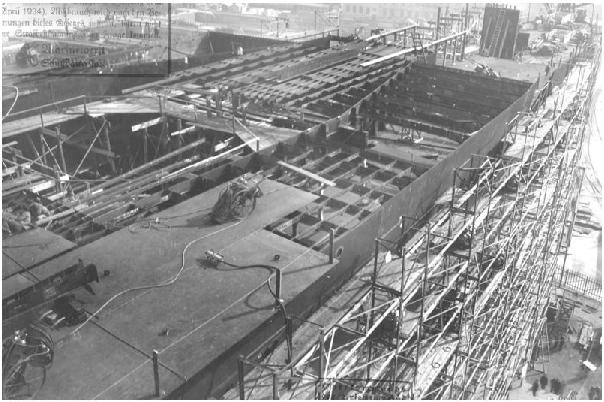
Graf Zeppelin II (Peter Strasser) -
Laid down at Germaniawerft, Kiel, probably in 1938. Work proceeded slowly; cancelled 3/1940 when approx. 60% completed and scrapped. Construction suspended in 1940, cancelled in 1943, incomplete hull scrapped before launching.. Name was planned but never officially assigned.
The Kriegsmarine had always maintained a policy of not assigning a name to a ship until it is launched. The first German carrier, laid down as "Flugzeugträger A" ("Aircraft carrier A"), was named Graf Zeppelin when launched in 1938. The second carrier — never launched — bore only the title "Flugzeugträger B", but might, if completed, have been called Peter Strasser.
Unfortunately the Germans overreached themselves. They had no experience of all the problems which had beset the early American, British and Japanese carriers despite of intense research done by scientists and engineers in smaller scales using modified merchantmen. But worst of all, the head of the Luftwaffe, Hermann Göring refused to allow his "empire" to be encroached upon, having said anything that flied in Germany belonged to him, by permitting the formation of a separate naval air force; even though the short-landing Fi 156, the clipped-winged Junkers Ju 87C and Messerschmitt Me 109T were ready. The result was that the Navy had to try to persuade the Luftwaffe to part with a small number of aircraft, and the wrangling went on until there was no hope of getting a carrier to sea.
The wrangles over aircraft were matched by arguments over the equipment of the ship, and construction was suspended in 1940. Work started on a revised design in 1942 but was stopped in 1943. The catapults were fitted partly on the flight deck when construction was ceased but they were never completed and eventually destroyed by a special German crew on 25 April 1945 when the hull was scuttled at Stettin.
Wilhelm Hadeler had been Assistant to the Professor of Naval Construction at the Technical University of Berlin for nine years when he was appointed to draft preliminary designs for an aircraft carrier in April 1934. The Anglo-German Naval Treaty signed 18 June 1935 allowed Germany to construct aircraft carriers with displacement up to 38,500 tons. In 1935, Adolf Hitler announced that Germany would construct aircraft carriers to strengthen the Kriegsmarine. A Luftwaffe officer, a naval officer and a constructor visited Japan in the autumn of 1935 to obtain flight deck equipment blueprints and inspect the Japanese aircraft carrier Akagi. The keel of Graf Zeppelin was laid down the next year. Two years later, Großadmiral (Grand Admiral) Erich Raeder presented an ambitious shipbuilding program called Plan Z, in which four carriers were to be built by 1945. In 1939, he revised the plan, reducing the number to two.
Having no experience building such ships, the Kriegsmarine had difficulty implementing advanced technologies such as steam-driven catapults into the Graf Zeppelin. German designers were able to study Japanese designs, but were constrained by the realities of creating a North Sea carrier vs. a "Blue Water" design. Several cruiser-type guns were envisioned to allow commerce raiding and defense against British cruisers, for example. This is in contrast to American and Japanese designs, which were more oriented toward a task-force defense, using supporting cruisers for surface firepower.
Details on how the Nazis planned to use the carrier in action have been lost to obscurity. The Germans had none of the experience that the American, British and Japanese navies had gained in the years between the wars. While the Graf Zeppelin had some advanced features she displayed her designers' lack of experience and knowledge about carriers. The heavy surface armament was of little use and accounted for too much weight; the anti-aircraft armament was heavy but badly sited, all on the starboard side. The radius of action was low for a fleet carrier intended to operate with the capital ships on the Atlantic shipping routes.
Had she been commissioned she would have provided a considerable commerce-raiding capability. The carrier could have provided effective support for capital ships and cruisers with air cover, and would have increased their potential for destruction considerably. Such support operations could have changed the outcome of sea battles like the sinking of the Battleships Bismarck and Tirpitz had the Graf Zeppelin been present.
The Germans have never sailed an aircraft carrier since.

Having had little experience with carrier construction, German designers and engineers were slowed by construction and design problems. This, added with Görings reluctance to allow a separate air arm other than the Luftwaffe, eventually halted construction of the aircraft carriers in April 1940. Graf Zeppelin, now laid up, had her artillery removed for use in coastal defences before she was towed to Gotenhafen.
In 1942 work was restarted on the carrier (having being moved back to Kiel in December 1942), as it was obvious at this time that the Kriegsmarine needed a ship of this type to support its major surface units. Graf Zeppelin was approximately 85% complete when work was once again halted in early1943 (work being stopped on Hitler’s orders after the Kriegsmarines poor performance during the Battle of the Barents Sea, 31st December 1942).
A review of the Führer's conferences on matters dealing with the German Navy, the minutes of which were captured after the fall of the Third Reich, reveals Hitler's vacillating interest in the carriers. Marshall Hermann Göring, Commander in Chief of the Luftwaffe, was resentful of any incursion on his authority as head of the country's air power and he frustrated Raeder at every opportunity. Within his own service, Raeder found opposition in Admiral Karl Doenitz, a submarine man.
By May 1941, the strain on manpower and raw materials was being felt in Germany. Raeder was still optimistic, however, and informed Hitler that Graf Zeppelin, then about 85 per cent complete, would be completed in about a year and that another year would be required for sea trials and flight training.
Though Hitler continued to assure Raeder that the carriers would be built, the Admiral's war with Göring had no truce and became increasingly bitter. Göring showed his contempt for the naval air arm by informing Hitler and Raeder that the aircraft ordered for Graf Zeppelin could not be available until the end of 1944. Göring's delaying tactics worked.
Construction on the carriers had been fitful from the start. Flugzeugträger B was abandoned in 1940 and broken up. Worker and material shortages plagued Graf Zeppelin.
Prior to launch, the carrier air group emphasis had been reconnaissance similar to contemporary Royal Navy concepts. The original air complement was to be 20 Fieseler Fi 167 biplanes for scouting and torpedo attack, ten Messerschmitt Bf 109T fighters, and thirteen Junkers Ju 87G dive bombers. Emphasis changed to offensive capabilities following observation of Japanese aircraft carrier operations against China in 1937. Poor performance of the Fi 167 changed the planned airgroup to thirty Messerschmitt fighters and twelve Junkers dive bombers.
Prodded by Raeder, Hitler ordered Göring to produce aircraft for the carrier and under this pressure, the air marshal offered redesigned versions of the Junkers Ju 87B Stuka and the Messerschmitt Bf 109E, which were at that time being phased out of the Luftwaffe first-line squadrons. Raeder was unhappy, but he had to accept them or none at all (including Göring's insistence that the flying personnel would remain under Luftwaffe command). All this forced another delay in the construction of the carrier: the flight deck installations had to be changed.
Later in 1942 projects for naval aircraft included the Me 155 V2 and Ju 87E (navalized D version). None of the Ju 87E were completed.
By 1943, Hitler had become disenchanted with his Navy. Raeder was relieved at his own request and Dönitz, the submarine admiral, took the top naval post. Work on the 95% complete carrier stopped; all armaments were removed and transferred to coastal batteries in Norway. The hull itself was used to store hardwood for the Kriegsmarine.
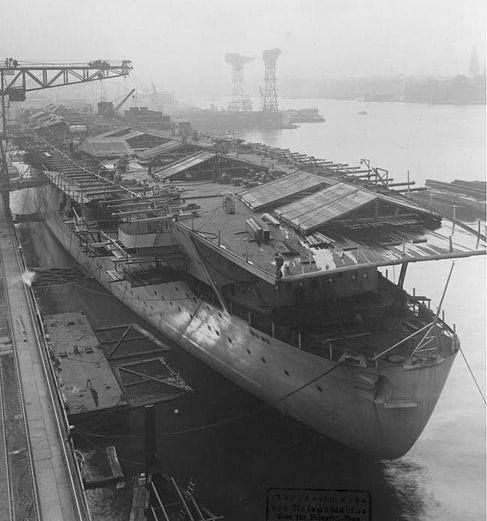
As the end of World War II neared, Graf Zeppelin was scuttled in shallow water at Szczecin (known to the Germans as Stettin) on 25 April, 1945 just before the Red Army captured the city. But she wasn’t quite ready for the scrap yard yet.
After Germany's surrender the Russians raised it. Loaded with booty and with her hangars full of sections of U-boats, captured booty, military parts and other bulky items, for use in the Soviet Union.she left Stettin in tow for Leningrad in August 1947.
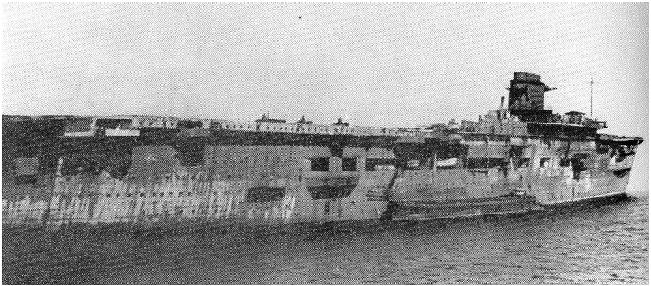
The carrier's history and fate after Germany's surrender was unclear for decades after the war. According to the terms of the Allied Tripartite Commission, a "Category C" ship (damaged or scuttled) should have been destroyed or sunk in deep water by August 15, 1946. Instead, the Soviets decided to repair the damaged ship and it was refloated in March 1946. The last known photo of the carrier shows it leaving Swinoujscie (before 1945 Swinemünde) on April 7, 1947. The photo appears to show the carrier deck loaded with various containers, boxes and construction elements, hence the supposition that it was probably used to carry looted factory equipment from Poland and Germany to the Soviet Union.
For many years, no other information about the ship's fate was available. There was some speculation that it was very unlikely that the hull made it to Leningrad, as it was argued that the arrival of such a large and unusual vessel would have been noticed by Western intelligence services. This seemed to imply that the hull was lost at sea during transfer between Swinoujscie and Leningrad. One account concluded that it struck a mine north of Rügen on August 15, 1947, but Rügen, west of Swinemünde, is not on the sailing route to Leningrad. Further north in the Gulf of Finland, a heavily-mined area difficult for Western observers to monitor, seemed more likely.
Another account specifies that the Soviets designated Graf Zeppelin "PO-101" (Floating Base Number 101), towed a short way from the naval polygon off Swinemünde to be anchored as a training target for Russian dive-bombers and torpedo vessels. The tests began on 16 August 1947. Planes and ships shot shells and dropped bombs on her to demonstrate how to sink a carrier, presumably American. After twenty-four hits the Graf Zeppelin stayed afloat and had to be finished off by torpedoes. In total the carrier withstood 24 hits scored by the Russians before finally sinking to the bottom: two 1000kg, two 500kg, three 250kg and five 100kg aerial bombs; four 180mm shells weighing 92kg; six bombs dropped by fleet dive-bombers; and two 533mm torpedo-hits. This assault would both comply with the Tripartite mandate (albeit late) and provide the Soviets with experience in sinking an aircraft carrier.
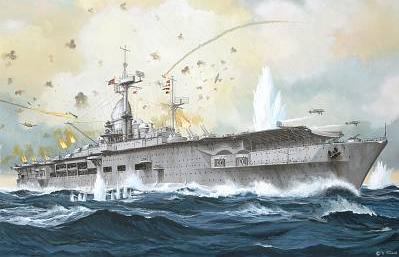
After the opening of the Soviet archives, new light was shed on the mystery. Though some believed that the carrier had been towed to Leningrad after the war, in his book "Without wings, the story of Hitler's aircraft carrier" Burke disputed this. What is known is that the carrier was briefly designated as "PO-101" (Floating Base Number 101) until, on August 16, 1947, it was used as a practice target for Soviet ships and aircraft. Allegedly the Soviets installed aerial bombs on the flight deck, in hangars and even inside the funnels (to simulate a load of combat munitions), and then dropped bombs from aircraft and fired shells and torpedoes at it. This assault would both comply with the Tripartite mandate (albeit late) and provide the Soviets with experience in sinking an aircraft carrier. By this point, the Cold War was underway, and the Soviets were well aware of the large numbers and central importance of aircraft carriers in the U.S. Navy, which in the event of an actual war between the Soviet Union and the United States would be targets of high strategic importance. After being hit by 24 bombs and projectiles, the ship did not sink and had to be finished off by two torpedoes. The exact position of the wreck was unknown for decades.
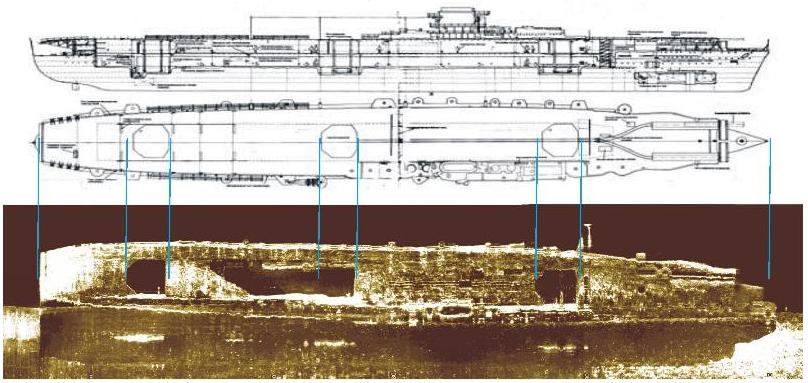
Hitler's first -- and last -- aircraft carrier. The ship sank for good sometime after World War II, but exactly where and why was an enduring mystery of the early Cold War.
On July 12, 2006 RV St. Barbara, a ship belonging to the Polish oil company Petrobaltic found a 265 m long wreck close to the port of Leba (a BBC report says 55 km north of Wladyslawowo) which they thought was most likely Graf Zeppelin. On July 26, 2006 the crew of the Polish Navy's survey ship ORP Arctowski commenced penetration of the wreckage to confirm its identity, and the following day the Polish Navy confirmed that the wreckage was indeed that of Graf Zeppelin. She rests at more than 87 meters (264 feet) below the surface.
Divers working for the Polish oil firm Petrobaltic on Monday discovered the rusting hulk of Nazi Germany's only aircraft carrier, the Graf Zeppelin, sunk in mysterious circumstances by the Soviets after World War II. Its exact location had been a riddle for almost 60 years.
Experts in the Polish Navy, using robots and sonar, confirmed on Thursday that the wreckage really was the Graf Zeppelin. The 260-meter (850-foot) ship had been a showpiece of Hitler's navy, but it never went into battle. Intended to carry 42 planes, the vessel was begun in 1936, launched in 1938, but never finished before German troops had to scuttle it in 1945. It was "a grandiose technical achievement," military historian Ulrich Israel told SPIEGEL ONLINE, "mainly when you consider that the Germans had no examples to work from to build such a carrier."
Hitler started the war before the German navy finished building its prestige ship. His planners gave priority to building U-Boats, and the Graf Zeppelin had to be towed to Gdansk, where it was used for storage. The Germans finally anchored it in a shallow stream feeding the Oder, where troops blew holes in its hull before they fled the invading Red Army. The Soviets renovated the ship, and moved it -- but how it met its final end is still the subject of controversy.
One story says the carrier hit a mine on its way to Russia. Another says the Soviets overloaded it with war booty, causing it to sink in a storm on the Baltic. But Ulrich Israel -- who's written a book about the ship -- claims the still-unfinished Graf Zeppelin was towed from its final harbor in the German town of Swinemünde in August 1947 and destroyed by Soviet bombs and torpedoes. The Russians, evidently with an eye on the American navy, wanted to practice sinking a foreign aircraft carrier.
While sounding for oil deposits in the Baltic Sea, Polish workers discovered the wreck about 55 kilometers (34 miles) outside the Polish harbor town of Wladyslawowo, near Gdansk. According to international maritime law the remains belong to the Federal Republic of Germany, but the German Defense Ministry told news agency ddp that jurisdiction is still under discussion. In the meantime, the ship's mysteries are far from fully solved.
"It's difficult to say why the Russians have always been so stubbornly reluctant to talk about the location of the wreck," Lukasz Orlicki, a Polish maritime historian, told the Times of London. "Perhaps it was the usual obsession with secrecy, or perhaps there was some kind of suspect cargo."
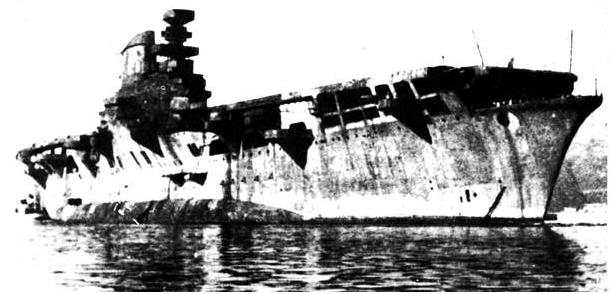
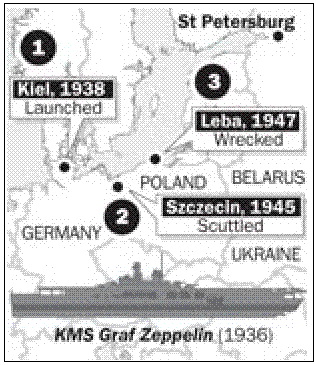
=================================================================================
NB: The above text has been collected / excerpted / edited / mangled / tangled / re-compiled / etc ... from the following online sources :
KM - Graf Zeppelin class aircraft carriers - http://www.hazegray.org
KM - German Aircraft Carrier/ Russian Floating Base - www.battleships-cruisers.co.uk
KM - Graf Zeppelin class aircraft carrier - wikipedia article #1
KM - German aircraft carrier Graf Zeppelin - wikipedia article #2
KM - German aircraft carrier Graf Zeppelin - www.battle-fleet.com
KM - German aircraft carrier Graf Zeppelin - /Pentagon/2833/kriegsmarine/carrier/
KM - The Only Nazi Aircraft Carrier - Graf Zeppelin - www.damninteresting.com
KM - Hitler's Showpiece Aircraft Carrier Found - www.spiegel.de
